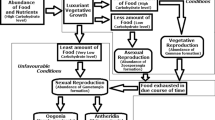Abstract
In the life cycle of ferns, germinated spores develop to prothallia, on which archegonia and anteridia are formed. Fertilization of eggs in the archegonia with sperms from the antheridia results in the production of young sporophytes. In 1950, Döpp1 demonstrated that mature Pteridium aquilinum prothallia produced hormonal substance(s) inducing antheridial formation in many species of the ferns Polypodiaceae. Since then, more than ten fern species have been reported2–4 to produce such antheridiuminducing substances, which were designated as antheridiogens.5 Though it has been shown,6 based on cross-testing of biological activities, that there are several different types of fern antheridiogens, only four have been characterized.7–11 All the antheridiogens characterized were derived from schizaeaceous ferns, and they are all gibberellin (GA)-related compounds. The purpose of this article is to review chemical structures and biological activities of the antheridiogens and to discuss their biosynthetic relationships.
Access this chapter
Tax calculation will be finalised at checkout
Purchases are for personal use only
Preview
Unable to display preview. Download preview PDF.
Similar content being viewed by others
References
Döpp W. Eine die Antheridienbildung bei Farnen fördernde Substanz in den Prothallien von Pteridium aquilinum L. (Kuhn). Ber Dtsch Bot Ges. 1950; 63: 139–147.
Näf U, Nakanishi K, Endo M, On the physiology and chemistry of fern antheridiogens. Bot Rev. 1975; 41: 315–359.
Emigh V, Farrar DR. Gemmae: A role in sexual reproduction in the fern genus Vittaria. Science. 1977; 198: 297–298.
Yamane H, Nohara K, Takahashi N, et al. Identification of antheridic acid as an antheridiogen in Anemia rotundifolia and Anemia flexuosa. Plant Cell Physiol. 1987; 28: 1203–1207.
Näf U. On dark-germination and antheridium formation in Anemia phyllitidis. Physiol Plant. 1966; 19: 1079–1088.
Näf U. On separation and identity of fern antheridiogens. Plant Cell Physiol. 1968; 9: 27–33.
Nakanishi K, Endo M, Näf U, et al. Structure of the antheridium-inducing factor of the fern Anemia phyllitidis. J Amer Chem Soc. 1971; 93: 5579–5581.
Corey EJ, Myers AG, Takahashi N, et al. Constitution of antheridiuminducing factor of Anemia phyllitidis. Tetrahedron Lett. 1986; 27: 5083–5084.
Yamane H, Takahashi N, Takeno K, et al. Identification of gibberellin A9 methyl ester as a natural substance regulating formation of reproductive organs in Lygodium japonicum. Planta. 1979; 147: 251–256.
Yamane H, Sato Y, Nohara K, et al. The methyl ester of a new gibberellin, GA73: The principal antheridiogen in Lygodium japonicum. Tetrahedron Lett. 1988; 29: 3959–3962.
Furber M, Mander LN, Nester JE, et al. Structure of a novel antheridiogen from the fern Anemia mexicana. Phytochemistry. 1989; 28: 63–66.
Corey EJ, Myers AG. Total synthesis of (±)-antheridium-inducing factor (AAn 2) of the fern Anemia phyllitidis. Clarification of stereochemistry. J Amer Chem Soc. 1985; 107: 5574–5576.
Furber M, Mander LN. Conversion of gibberellin A7 into antheridic acid, the antheridium inducing factor from the fern Anemia phyllitidis: A new protocol for controlled 1,2-bond shifts. J Amer Chem Soc. 1987; 109: 6389–6396.
Zanno PR, Endo M, Nakanishi K, et al. On the structural diversity of fern antheridiogens. Naturwissenschaften. 1972; 59: 512.
Nester JE, Veysey S, Coolbaugh RC. Partial characterization of an antheridiogen of Anemia mexicana: Comparison with the antheridiogen of A. phyllitidis. Planta. 1987; 170: 26–33.
Näf U. On the control of antheridium formation in the fern species Lygodium japonicum. Proc Soc Exp Biol Med. 1960; 105: 82–86.
Näf U. Control of antheridium formation in the fern species Anemia phyllitidis. Nature. 1959; 184: 798–800.
Schraudolf H. Die Wirkung von Phytohormonen auf Keimung und Entwicklung von Farnprothallien. I. Auslösung der Antheridienwirkung und Dunkelkeimung bei Schizaeaceen durch Gibberellinsäure. Biol Zentralbl. 1962; 81: 731–740.
Hiraga K, Yamane H, Takahashi N. Biological activity of some synthetic gibberellin glucosyl esters. Phytochemistry. 1974; 13: 2371–2376.
Satoh Y. Studies on plant growth regulators controlling the life cycle of pteridophytes. Ph.D. thesis, The University of Tokyo, 1984.
Takeno K, Yamane H, Nohara K, et al. Biological activity of antheridic acid, an antheridiogen of Anemia phyllitidis. Phytochemistry. 1987; 26: 1855–1857.
Brian PW, Grove JF, Mulholland TPC. Relationships between structure and growth-promoting activity of gibberellins and some allied compounds, in four test systems. Phytochemistry. 1967; 6: 1475–1499.
Takeno K, Yamane H, Yamauchi T, et al. Biological activities of the methyl ester of gibberellin A73, a novel and principal antheridiogen in Lygodium japonicum. Plant Cell Physiol. 1989; 30: 201–205.
Sugai M, Nakamura K, Yamane H, et al. Effects of gibberellins and their methyl esters on dark spore germination and antheridium formation in Lygodium japonicum and Anemia phyllitidis. Plant Cell Physiol. 1987; 28: 199–202.
Sato Y, Yamane H, Kobayashi M, et al. Metabolism of GA9 methyl ester in prothallia of Lygodium japonicum. Agric Biol Chem. 1985; 49: 255–258.
Yamane H, Yamaguchi I, Kobayashi M, et al. Identification of ten gibberellins from sporophytes of the tree fern, Cyathea australis. Plant Physiol. 1985; 78: 899–903.
Murofushi N, Nakayama M, Takahashi N, et al. 12-Hydroxylation of gibberellins A12 and A14 by prothallia of Lygodium japonicum and identification of a new gibberellin, GA74. Agric Biol Chem. 1988; 52: 1825–1828.
Editor information
Editors and Affiliations
Rights and permissions
Copyright information
© 1991 Springer-Verlag New York Inc.
About this paper
Cite this paper
Yamane, H. (1991). Antheridiogens of Schizaeaceous Ferns: Structures, Biological Activities, and Biosynthesis. In: Takahashi, N., Phinney, B.O., MacMillan, J. (eds) Gibberellins. Springer, New York, NY. https://doi.org/10.1007/978-1-4612-3002-1_37
Download citation
DOI: https://doi.org/10.1007/978-1-4612-3002-1_37
Publisher Name: Springer, New York, NY
Print ISBN: 978-1-4612-7754-5
Online ISBN: 978-1-4612-3002-1
eBook Packages: Springer Book Archive




